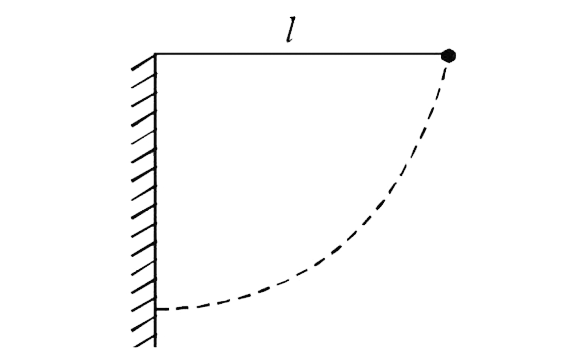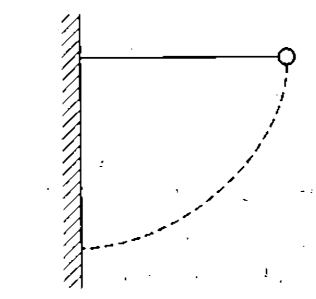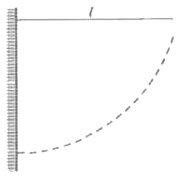A simple pendalum is suspended from a peg on a verticle wall . The pendulum is pulled away from the well is a horizental position (see fig) and released . The bell his the well the coefficient of resitution being 2√5

what is the miximum number of colision after which the amplitube of secillections between less that 60 digree ? Solution in Gujrati
The correct Answer is:4

After 1st collision
−2√5√2gl=√2gl(1−cosθ)
cosθ15
Fro IInd collision
2√5.2√5√2gl=√2gl(1−cosθ)
For nth collision
(2√5)n=√1−cosθ⇒(45)n=1−cosθ
cosθ=1−(45)n
Put n=0,1,2,3 and get answer
Topper's Solved these Questions
- CENTRE OF MASSBOOK - ALLEN CHAPTER - CENTRE OF MASSEXERCISE - EXERCISE-IV B
14 Videos
- CENTRE OF MASSBOOK - ALLEN CHAPTER - CENTRE OF MASSEXERCISE - EXERCISE-V A
20 Videos
- CENTRE OF MASSBOOK - ALLEN CHAPTER - CENTRE OF MASSEXERCISE - EXERCISE-III
41 Videos
- BASIC MATHEMATICS USED IN PHYSICS &VECTORS BOOK - ALLEN CHAPTER - BASIC MATHEMATICS USED IN PHYSICS &VECTORS EXERCISE - EXERCISE-IV ASSERTION & REASON
11 Videos
- ELASTICITY, SURFACE TENSION AND FLUID MECHANICSBOOK - ALLEN CHAPTER - ELASTICITY, SURFACE TENSION AND FLUID MECHANICSEXERCISE - Exercise 5 B (Integer Type Questions)
3 Videos
Similar Questions
A bullet of mass M is fired with a velocity 50m/s at an angle with the horizontal. At the highest point of its trajectory, it collides head-on with a bob of mass 3M suspended by a massless string of length 10/3 metres and gets embeded in the bob. After the collision, the string moves through an angle of 120∘. Find
(i) the angle θ,
(ii) the vertical and horizontal coordinates of the initial position of the bob with respect to the point of firing of the bullet. Take g=10m/s2
View SolutionTwo identical particles move towards each other with velocity 2v and v respectively. The velocity of centre of mass is
View SolutionA particle of mass m, kinetic energy K and momentum p collision head on elastically with another particle of mass 2m at rest. After collision. :
Column IColumn II(A)Momentum of first particle(p)3/4p(B)Momentum of second particle(q)−K/9(C)Kinetic energy of first particle(r)−p/3(D)Kinetic energy of second particle(s)8K9None
View SolutionAssertion: If the initial and final positions coincide, the displacement is a null vector.
Reason: A physical quantity can not be called a vector, if its magnitude is zero.
View SolutionTwo soap bubbles A and B are kept in a closed chamber where the air is maintained at pressure 8N/m2.The radii of bubbles A and B are 2cm and 4cm, respectively. Surface tension of the soap-water used to make bubbles is 0.04N/m. Find tha ratio nB/nA, where nA and nB are the number of moles of air in bubbles A and B, respectively. [Neglect the effect of gravity.]
View SolutionA simple pendulum is hanging from a peginserted in a vertical wall. Its bob is strteched to horizontal position form wall and left freee to move, the bob hits the wall. If coefficient of restitution is (2)/(sqrt(5)) . After how many collisions the amplitude of vibration will becomes less then 60^(@) .
View SolutionA simple pendulum is suspended from a peg on a wall which is inclined at an angle of 30^(@) with the vertical. The pendulum is pulled away from the wall to a horizontal position (with string just taut) and released. The bob repeatedly bounces off the wall, the coefficient of restitution being e = (2)/(sqrt(5)) Find the number of collisions of the bob with the wall, after which the amplitude of oscillation (meaured from the wall) becomes less than 30^(@)
View SolutionA simple pendulum is hanging from a peg inserted in a vertical wall. Its bob is stretched in horizontal position from the wall and is left free to move. The bob hits on the wall the coefficient of restitution After how many collsions the amplitude of vibration will become less than 60∘
View SolutionThe figure shows a pendulum of length l suspended at a distance x vertically above a peg. (a) The pendulum bob is deflected through an angle theta and then released. Find the speed of the bob at the instant (b) The pendulum is released when theta = 90^(@) . For what x (position of peg) will the pendulum complete the circle ? (c) The pendulum is released when theta = 60^(@) . what is the velocity of the bob as it passes position E.
View SolutionA simple pendulum is supended from a peg on a verticl wall. The pendulum is pulled away from the wall to a horizontal position and releases as shown in figure −4.152. The ball hits the wall, the coefficient of restitution being 2/√2. What is the minimum number of collisions after which the amplitude of oscillation becomes less than 60∘

View SolutionA pendulum bob on a 2 m string is displaced 60^(@) from the verticle and then released . What is the speed of the bob as it passes through the lowest point in its path?
View SolutionA simple pendulum is suspended from the ceiling of a train which is moving with an acceleration a .The angular of inclination of the pendulum from the vertical will be
View SolutionA ladder 5 m long is leaning against a well. The bottom of the ladder is pulled along the ground, away from the well, at the rate of 2 m/s. How fat is its height on the wall decreasing when the foot of the ladder is 4m away from the wall?
View Solutionएक सरल लोलक खूँटी (Peg) की सहायता से ऊर्ध्वाघर दीवार पर लटकाया गंया है। लोलक को खींचकर चित्रानुसार दीवार से दूर क्षैतिज स्थिति में लाया जाता है तथा छोड़ दिया जाता है। गोलक दीवार से टकराता है, यदि प्रत्यावस्थान गुणांक (Coefficient of restitution) 2√5, हो, तो संघट्टों की कम-से-कम कितनी संख्या होगी, जिनके बाद दोलनों का आयाम 60∘ से कम रह जाएगा?

View SolutionMass of the bob of a simple pendulum is 10g and the effective length is 13 cm. The bob is pulled 5 cm away from the vertical and then released. What will be the kinetic energy of the bob when it passes through the lowest point?
View SolutionFrom a rod fixed on a vertical wall, a simple pendulum is suspended. Its bob is pulled away from the wall to a horizontal position and then released. If the coefficient of restitution is 2/sqrt(5) , what would be the minimum number of impacts of the bob with the wall, after which the amplitude of the pendulum becomes less than 60^@ ?
View Solution
